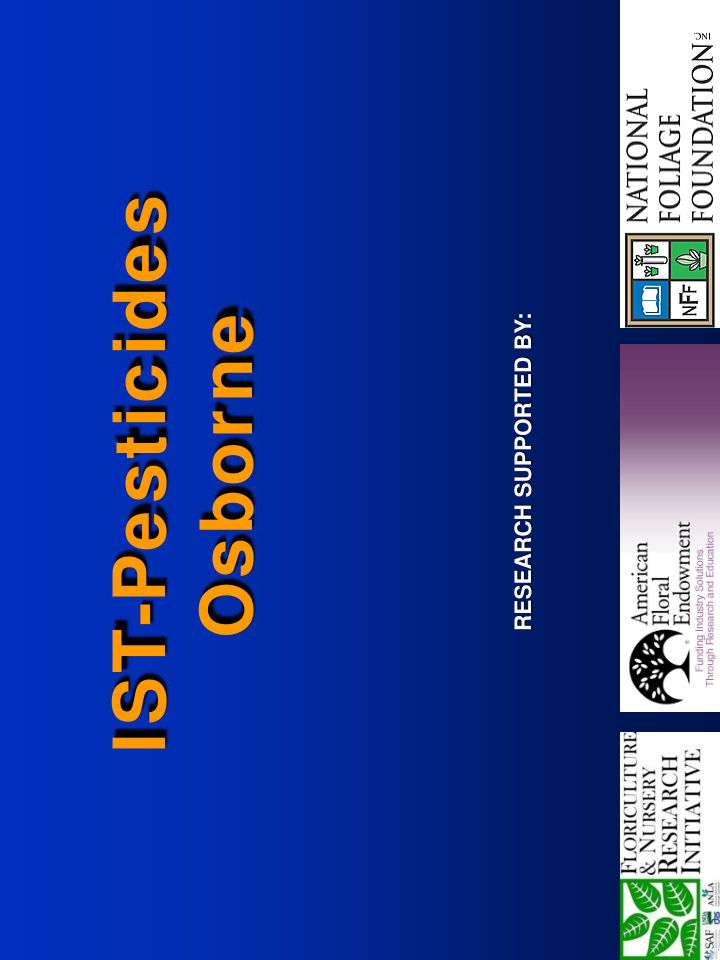



IST-Pesticides RESEARCH SUPPORTED BY: Osborne
Natural Enemies – “Bugs eating Bugs” What natural enemies are available? How can natural enemies be used? Impact of insecticides on natural enemies?
Natural Enemies “Bugs eating Bugs” What natural enemies are available? Commercial: ANBP- ANBP.ORG Applied Bionomics-APPLIEDBIO- NOMICS.COM Biobest-BIOBEST.BE Koppert-KOPPERT.NL Rincon Vitova- RINCONVITOVA.COM SyngentaBioline-SyngentaBioline.com
Feltiella acarisuga
Feltiella acarisuga
Cotesia sp.
Lacewing adults
Zelus longipes
A sachet contains bran, Carpoglyphus lactis (Dried Fruit Mite or Sugar Mite) and the predatory mite A. swirskii .
Paecilomyces fumosoroseus PFR-97 Apopka
Natural Enemies “Bugs eating Bugs” What natural enemies are available? Homeowners: ???
Natural Enemies “Bugs eating Bugs” How can natural enemies be used?
Types of Biological Control and Implementation Conservation biological control (no releases, limit pesticide usage and protect resources used by established natural enemies)
Types of Biological Control and Implementation Classical biological control (usually targeted at an alien pest and self-sustaining)
16 Introduce natural enemies Natural Enemy Releases 14 EIL 12 10 (years) Time 8 6 Introduction of pest 4 2 10 5 0
Types of Biological Control and Implementation Inoculative biological control (usually not self-sustaining, releases at beginning of the cycle)
Begin cycle Inoculative Releases cycle End EIL 8 (Months) 7 Time Introduce natural enemies 6 5 4 Begin cycle 1 0.5 0
Types of Biological Control and Implementation Inundative biological control
Begin cycle Inundative Releases cycle End EIL 8 Introduce natural enemies (Months) 7 Time 6 5 4 Begin cycle 1 0.5 0
Types of Biological Control and Implementation Augmentative or Seasonal Inoculative biological control (periodic releases, usually endemic natural enemies)
Seasonal Inoculative 1 Introduce natural enemies EIL 0.5 0 1 2 3 4 5 6 Time Begin Begin End Cycle (months) Cycle Cycle
Seasonal Inoculative Banker Plants 1 Introduce banker plants EIL 0.5 0 1 2 3 4 5 6 Time Begin Begin End Cycle (months) Cycle Cycle
Natural Enemies “Bugs eating Bugs” Impact of insecticides on natural enemies? Assume anything you spray w ill have a negative impact on most natural enemies!
Natural Enemies “Bugs eating Bugs” Impact of insecticides on natural enemies? APPLIEDBIO-NOMICS.COM BIOBEST KOPPERT
Selected Miticides for Use on Ornamental Plants lin k
Mites are the KEY pest in systems. many
In the United States, 34% of all pesticides applied to ornamentals were for mite control (1996).
SCOUT SCOUT SCOUT SCOUT SCOUT SCOUT SCOUT SCOUT SCOUT SCOUT SCOUT SCOUT SCOUT SCOUT SCOUT SCOUT SCOUT SCOUT SCOUT SCOUT SCOUT
IDENTIFICATION mrec.ifas.ufl.edu/lso
Tenuipalpidae
Brevipalpus spp.
CHEMICAL CONTROL Avid ProMITE Sanmite Shuttle Sulfur
Tarsonemidae
Broad Mite and Cyclamen Mite
Broad Mite
How do broad mites get into the greenhouse? Insects Air currents Crawling and contact Infested transplants
Polyphagotarsonemus latus
Polyphagotarsonemus latus
CHEMICAL CONTROL Akari Avid Pylon Sanmite Thiodan*
Tetranychidae
GLOVER MITE
TUMID MITE
T. tumidus = white & red eggs TUMID MITE = red eggs T. gloveri
Twospotted Spider Mite
Twospotted Spider Mite
Recommend
More recommend